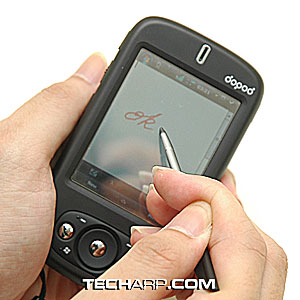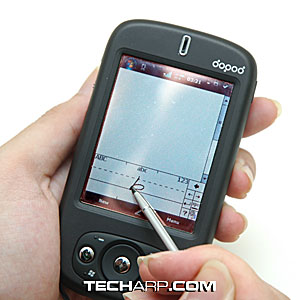Data Input
Input options are extremely limited on paper. You can either write using a pen or pencil, or use stencils and stamps. I’m sure most people would not choose the latter for sensible reasons. When it comes to PDA phones though, their Windows Mobile operating system offers a variety of input choices.
Transcriber
 Let’s start with Transcriber, which is Windows Mobile’s state-of-the-art natural handwriting recognition technology. Transcriber is my preferred input method because it truly is excellent at what it is designed to do.
Let’s start with Transcriber, which is Windows Mobile’s state-of-the-art natural handwriting recognition technology. Transcriber is my preferred input method because it truly is excellent at what it is designed to do.
Not only does it support complete sentence writing at one go (which mimics how we normally write on paper), it also supports cursive and continuous handwriting. It pretty much gives paper organizers a run for their money.
However, this input system requires some practice to master. It can take a long time to really get used to it.
But what's worse is the fact that Transcriber can only recognize commonly-used words. Trying to get an unknown word (i.e. in a different language) recognized can be really troublesome. This is where the single letter recognizers come in.
Block & Letter Recognizers
There are two different letter recognizers - the Block Recognizer and the Letter Recognizer. Both methods recognize single-letter inputs. The difference is the Block Recognizer works for single-stroke inputs also.
Almost any word and any letter/number combination can be made easily using these two recognizers. The drawback is there is no proper writing flow, as you will be writing the letters in the same area continuously. This is reminiscent of the dedicated writing area in old Palm PDAs.


Keyboard
If you are too lazy to write, don’t fret. There’s even an option for a virtual keyboard. When you select the keyboard option, it displays a fully-functional QWERTY keyboard. You just need to tap on the letters. It's obvious why this would be a very popular method of typing in data.
Certain PDA phones (e.g. the HTC TyTn and the Dopod 838 Pro) come with a physical QWERTY keyboard. Such physical keyboards naturally work better than their virtual cousins, with data input speeds that will put handwriting to shame. The inclusion of a keyboard doesn’t usually affect the overall size of the PDA phone too much so there’s no surprise why such models are a great hit among consumers.
Analog Or Digital Then?
With all those great input options offered by PDA phones, what does pen and paper have to offer? Just one thing, but it's probably the only thing that truly matters - 100% accuracy on handwriting recognition.
No matter how great handwriting recognition technology is, there will always be some inaccuracies in deciphering your handwriting, even if it's neat. No one using pen and paper will ever need to contend with such mistakes. Even if we make a spelling mistake, we humans can easily perceive the actual words or the underlying message.
Paper also provides a seamless integration of sketches and other drawings, together with handwritten text. Although Windows Mobile allows that as well, it limits sketches and free handwriting to the Notes section. This kind of limitation impinges on your creativity.
Although very powerful, Transcriber does not have the omnipotent handwriting recognition that we all dream for. It cannot provide 100% accuracy in word recognition due to differences in human writing (nobody’s perfect!), and it can recognize words that are in its dictionary. You can add words to the dictionary, but that itself is a limitation.
The Block/Letter Recognizers are limited to a small writing area at the bottom. Those used to old Palm PDAs will have no problem adapting, but for a new user, that will not be as intuitive or as flexible as writing on any area of the screen.
The virtual QWERTY keyboard provides a fast and accurate input method, but it makes you feel like a robot chicken pecking away at the tiny keys. The physical QWERTY keyboard in some PDA phone models is the most decent text input method, but it's limited to a few, expensive models and it does increase the size of the phone.
Therefore, the pen and paper combo is still better than Windows Mobile’s software inputs when you factor in the writing experience and accuracy of handwriting recognition. However, when it comes to speed, these digital inputs are much better because of their advanced programming and the ability to convert simple keystrokes to full words. The physical keyboard is even faster and more accurate.







 Add to Reddit
Add to Reddit
